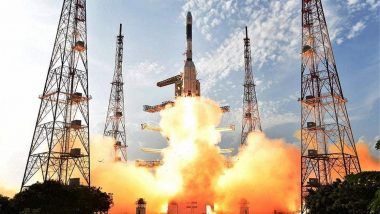New Delhi, July 7: The Indian Space Research Organisation (ISRO) is scheduled to script history in the wee hours of July 15, when it will launch India's second mission to the moon. All eyes are set on the project's launch, which is being promoted as a landmark event in the history of country's space programmes.
If successful, Chandrayaan 2 would make India the fourth nation -- after the United States, China and Russia -- to successfully perform a "soft landing" of an unmanned mission on the moon. Chandrayaan-2 First Look: ISRO Unveils Modules of India's Second Lunar Mission
Chandrayaan 2: Project Cost
The spacecraft, with a mass of 3.8 tonne, has three modules -- Orbiter, Lander (Vikram) and Rover (Pragyan). This aspect of the project will cost nearly Rs 603 crore. With Geosynchronous Satellite Launch Vehicle Mark III, the cost will surge by around Rs 375 crore.
The overall cost is thus being pegged at around Rs 1,000 crore -- making it one of the most expensive space programmes of the nation.
Launch Date
On June 15, launch would take place at 2.51 am on board the GSLV MK-III vehicle from the spaceport of Sriharikota.
The landing on the moon near the South Pole, an uncharted territory so far, would be on September 6 or 7, confirmed ISRO chief K Sivan.
Other Details of The Chandrayaan 2 Project
According to the ISRO, Orbiter, with scientific payloads, would orbit around the moon. Lander would soft land on the moon at a predetermined site and deploy Rover.
The scientific payloads on board Orbiter, Lander and Rover are expected to perform mineralogical and elemental studies of the lunar surface.
The Orbiter and Lander modules would be interfaced mechanically and stacked together as an integrated module and accommodated inside the GSLV MK-III launch vehicle. Rover is housed inside Lander.
After the launch into an earth-bound orbit by GSLV MK-III, the integrated module would reach the moon orbit using the orbiter propulsion module and subsequently, Lander would separate from Orbiter and soft land at the predetermined site, close to lunar South Pole, the ISRO said.
Rover would roll out for carrying out scientific experiments on the lunar surface, it said, noting that instruments were also mounted on Lander and Orbiter for carrying out scientific experiments.
Chandrayaan-2 is an advanced version of the previous Chandrayaan-1 mission, which was launched about 10 years ago.
Chandrayaan-1 had 11 payloads -- five from India, three from Europe, two from the US and one from Bulgaria -- and the mission had the credit for discovery of water on the lunar surface. The 1.4-tonne spacecraft was launched using PSLV and the orbiter had orbited 100 km from the lunar surface.
(The above story first appeared on LatestLY on Jul 07, 2019 04:55 PM IST. For more news and updates on politics, world, sports, entertainment and lifestyle, log on to our website latestly.com).













 Quickly
Quickly












